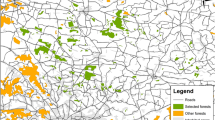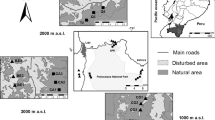Abstract
Rapid economic development has led to high rates of deforestation and widespread alteration of land cover in many regions in China, where many primary forests have been replaced by secondary and plantation forests. Therefore, we aimed to determine differences in bird community diversity and structure between three forest types. We assessed differences in species richness, phylogenetic and functional diversity and community structure of bird communities in primary, secondary and plantation forests. Data was collected over four meteorological seasons from bird communities in a nature reserve in the Hengduan Mountains, China. We found that functional and phylogenetic diversity in secondary forest were significantly greater than in primary forest, while species richness was not significantly different. Thus, simple metrics (i.e. species richness) may not be sufficient to assess forest conservation value. We suggest that it is necessary to use varied diversity metrics that incorporate species’ similarities and differences. It also appears that secondary forests play an important role in the maintenance of studied bird biodiversity. The results of community structure analyses show that the habitat filter was strongest in the primary forest, leading to primary forest species being lighter in weight, shorter in body length, and with longer tarsometatarsus. These species were specialized and forest-dependent, reflecting the value of primary forests as an irreplaceable habitat type for several species after nearby forests are degraded.






Similar content being viewed by others
Data availability
The data used to support the findings of this study are available from the corresponding author upon request.
References
Barlow J, Mestre LAM, Gardner TA, Peres CA (2007) The value of primary, secondary and plantation forests for Amazonian birds. Biol Conserv 136:212–231. https://doi.org/10.1016/j.biocon.2006.11.021
Betts MG, Hagar JC, Rivers JW, Alexander JD, McGarigal K, McComb BC (2010) Thresholds in forest bird occurrence as a function of the amount of early-seral broadleaf forest at landscape scales. Ecol Appl 20:2116–2130. https://doi.org/10.1890/09-1305.1
Bibby CJ, Burgess ND, Hill DA (2000) Bird census Techniques. Academic Press, London
Blomberg SP, Garland T, Ives AR (2003) Testing for phylogenetic signal in comparative data: behavioral traits are more labile. Evolution 57:717–745. https://doi.org/10.1111/j.0014-3820.2003.tb00285.x
Brockerhoff EG, Jactel H, Parrotta JA, Quine CP, Sayer J (2008) Plantation forests and biodiversity: oxymoron or opportunity? Biodivers Conserv 17:925–951. https://doi.org/10.1007/s10531-008-9380-x
Brown S, Lugo AE (1990) Tropical secondary forests. J Trop Ecol 6:1–32. https://doi.org/10.1017/S0266467400003989
Brown WP (2007) Body mass, habitat generality, and avian community composition in forest remnants. J Biogeogr 34:2168–2181. https://doi.org/10.1111/j.1365-2699.2007.01766.x
Buckland ST, Anderson DR, Burnham KP, Laake JL, Borchers DL, Thomas LN (2001) Introduction to distance sampling: estimating abundance of biology populations. Biometrics. Oxford University Press, Oxford
Cadotte MW, Davies TJ (2016) Phylogenies in ecology: a guide to concepts and methods. Princeton University Press, Princeton
Casas G, Darski B, Ferreira PMA, Kindel A, Müller SC (2016) Habitat structure influences the diversity, richness and composition of bird assemblages in successional Atlantic rain forests. Trop Conserv Sci 9:503–524. https://doi.org/10.1177/194008291600900126
Chazdon RL (2014) Second growth: the promise of tropical forest regeneration in an age of deforestation. The University of Chicago Press, Chicago
Cornwell WK, Schwilk DW, Ackerly DD (2006) A trait-based test for habitat filtering: convex hull volume. Ecology 87:1465–1471. https://doi.org/10.1890/0012-9658(2006)87[1465:Attfhf]2.0.Co;2
Cushman JH, Lawton JH, Manly BFJ (1993) Latitudinal patterns in European ant assemblages: variation in species richness and body size. Oecologia 95:30–37. https://doi.org/10.1007/BF00649503
Del Hoyo J, Elliott A, Sargatal J, Christie D, de Juana E (2017) Handbook of the birds of the world. Lynx Edicions, Barcelona
Dent DH, Joseph WS (2009) The future of tropical species in secondary forests: a quantitative review. Biol Conserv 142:2833–2843. https://doi.org/10.1016/j.biocon.2009.05.035
do Nascimento ER, Correia I, Ruiz-Esparza JM, Gouveia SF (2018) Disentangling phylogenetic from non-phylogenetic functional structure of bird assemblages in a tropical dry forest. Oikos 127:1177–1185. https://doi.org/10.1111/oik.04910
Drummond AJ, Rambaut A (2007) BEAST: Bayesian evolutionary analysis by sampling trees. BMC Evol Biol 7:214. https://doi.org/10.1186/1471-2148-7-214
Ellis TM, Betts MG (2011) Bird abundance and diversity across a hardwood gradient within early seral plantation forest. For Ecol Manage 261:1372–1381. https://doi.org/10.1016/j.foreco.2011.01.018
Elsen PR, Kalyanaraman R, Ramesh K, Wilcove DS (2017) The importance of agricultural lands for Himalayan birds in winter. Conserv Biol 31:416–426. https://doi.org/10.1111/cobi.12812
Erniwati E (2016) The value of secondary forest patches for bird conservation in palm oil landscapes of Riau, Sumatra. Biodivers J Biol Divers 17:791–798. https://doi.org/10.13057/biodiv/d170256
Faith D (1992) Conservation evaluation and phylogenetic diversity. Biol Conserv 61:1–10. https://doi.org/10.1016/0006-3207(92)91201-3
Felton A, Wood J, Felton AM, Hennessey B, Lindenmayer DB (2008) Bird community responses to reduced-impact logging in a certified forestry concession in lowland Bolivia. Biol Conserv 141:545–555. https://doi.org/10.1016/j.biocon.2007.11.009
Forboseh P, Keming E, Tohandinnocentn C, Wultof IN (2003) Monitoring of Kilum-Ijim forest bird communities: initial findings. Bird Conserv Int 13:255–271. https://doi.org/10.1017/S0959270903003198
Gale GA, Round PD, Pierce AJ, Nimnuan S, Pattanavibool A, Brockelman WY (2009) A field test of distance sampling methods for a tropical forest bird community. Auk 126:439–448. https://doi.org/10.1525/auk.2009.08087
Gower JC (1966) Some distance properties of latent root and vector methods used in multivariate analysis. Biometrika 53:325–338. https://doi.org/10.2307/2333639
Grau HR, Arturi MF, Brown AD, Aceñolaza PG (1997) Floristic and structural patterns along a chronosequence of secondary forest succession in Argentinean subtropical montane forests. For Ecol Manage 95:161–171. https://doi.org/10.1016/S0378-1127(97)00010-8
Hilbert J, Wiensczyk A (2007) Old-growth definitions and management: a literature review, vol 8. Canadian Institute for Studies in Publishing Press Simon Fraser University, Vancouver
Hsieh TC, Ma KH, Chao A (2016) iNEXT: an R package for rarefaction and extrapolation of species diversity (Hill numbers). Methods Ecol Evol 7:1451–1456. https://doi.org/10.1111/2041-210X.12613
Hua F et al (2016) Opportunities for biodiversity gains under the world’s largest reforestation programme. Nat Commun 7:12717. https://doi.org/10.1038/ncomms12717
Jetz W, Thomas GH, Joy JB, Hartmann K, Mooers AO (2012) The global diversity of birds in space and time. Nature 491:444–448. https://doi.org/10.1038/nature11631
Koskimies P (1989) Birds as a tool in environmental monitoring. Ann Zool Fenn 26:153–166
Kraft Nathan JB, Cornwell William K, Webb Campbell O, Ackerly David D (2007) Trait evolution, community assembly, and the phylogenetic structure of ecological communities. Am Nat 170:271–283. https://doi.org/10.1086/519400
Martin TE, Blackburn GA (2014) Conservation value of secondary forest habitats for endemic birds, a perspective from two widely separated tropical ecosystems. Ecography 37:250–260. https://doi.org/10.1111/j.1600-0587.2013.00234.x
McNeely JA, Miller KR, Reid WV, Mittermeier RA, Werner TB (1990) Conserving the world's biological diversity. IUCN, The World Bank, Gland, Washington, D.C.
Melo FPL, Arroyo-Rodríguez V, Fahrig L, Martínez-Ramos M, Tabarelli M (2013) On the hope for biodiversity-friendly tropical landscapes. Trends in Ecol Evol 28:462–468. https://doi.org/10.1016/j.tree.2013.01.001
Morales-Castilla I, Rodriguez MÁ, Hawkins BA (2012) Deep phylogeny, net primary productivity, and global body size gradient in birds. Biol J Linn Soc 106:880–892. https://doi.org/10.1111/j.1095-8312.2012.01917.x
Morales-Hidalgo D, Oswalt SN, Somanathan E (2015) Status and trends in global primary forest, protected areas, and areas designated for conservation of biodiversity from the global forest resources assessment 2015. For Ecol Manage 352:68–77. https://doi.org/10.1016/j.foreco.2015.06.011
Myers N, Mittermeier RA, Mittermeier CG, da Fonseca GAB, Kent J (2000) Biodiversity hotspots for conservation priorities. Nature 403:853–858. https://doi.org/10.1038/35002501
Nagy LR, Holmes RT (2005) Food limits annual fecundity of a migratory songbird: an experimental study. Ecology 86:675–681. https://doi.org/10.1890/04-0155
Newton I (1998) Population limitation in birds. Academic Press, San Diego
Padoa-Schioppa E, Baietto M, Massa R, Bottoni L (2006) Bird communities as bioindicators: the focal species concept in agricultural landscapes. Ecol Ind 6:83–93. https://doi.org/10.1016/j.ecolind.2005.08.006
Petchey OL, Gaston KJ (2002) Functional diversity (FD), species richness and community composition. Ecol Lett 5:402–411. https://doi.org/10.1046/j.1461-0248.2002.00339.x
Sekercioglu CH (2012) Bird functional diversity and ecosystem services in tropical forests, agroforests and agricultural areas. J Ornithol 153:153–161. https://doi.org/10.1007/s10336-012-0869-4
Si X et al (2017) Functional and phylogenetic structure of island bird communities. J Anim Ecol 86:532–542. https://doi.org/10.1111/1365-2656.12650
Si X et al (2018) The importance of accounting for imperfect detection when estimating functional and phylogenetic community structure. Ecology 99:2103–2112. https://doi.org/10.1002/ecy.2438
Soh MCK, Sodhi NS, Lim SLH (2006) High sensitivity of montane bird communities to habitat disturbance in Peninsular Malaysia. Biol Conserv 129:149–166. https://doi.org/10.1016/j.biocon.2005.10.030
Tilman D (2001) Functional diversity. In: Levin SA (ed) Encyclopedia of biodiversity. Elsevier, New York, pp 109–120
Tsirogiannis C, Sandel B (2016) PhyloMeasures: a package for computing phylogenetic biodiversity measures and their statistical moments. Ecography 39:709–714. https://doi.org/10.1111/ecog.01814
Webb CO et al (2010) Picante: R tools for integrating phylogenies and ecology. Bioinformatics 26:1463–1464. https://doi.org/10.1093/bioinformatics/btq166
Webb CO, Ackerly DD, McPeek MA, Donoghue MJ (2002) Phylogenies and community ecology. Annu Rev Ecol Syst 33:475–505. https://doi.org/10.1146/annurev.ecolsys.33.010802.150448
Whitman AA, Hagan JM, Nicholas VLB (1997) A comparison of two bird survey techniques used in a subtropical forest. Condor 99:955–965. https://doi.org/10.2307/1370146
Wu FEI, Liu L, Fang J, Zhang R, Yang X (2016) Conservation value of human-modified forests for birds in mountainous regions of south-west China. Bird Conserv Int 27:187–203. https://doi.org/10.1017/s0959270916000058
Zhang Q, Han R, Zou F (2011) Effects of artificial afforestation and successional stage on a lowland forest bird community in southern China. For Ecol Manage 261:1738–1749. https://doi.org/10.1016/j.foreco.2011.01.025
Zhao Z (2001) The handbook of the birds of China. Jilin Science and Technology Publishing House, Changchun
Acknowledgements
This study was financially supported by the Sichuan Meigu Dafengding National Nature Reserve. We grateful to Prof. Robert K. Colwell, Dr. Megan Price, Mr. Mike Seitz and three anonymous reviewers for their thoughtful comments and efforts towards improving our manuscript, as well as their help in language polishing.
Funding
This work was supported by the Fundamental Research Funds for the Central Universities (SCU2019D013), the National Natural Science Foundation of China (Nos. 31772478, 31501851), and the Second Tibetan Plateau Scientific Expedition and Research Program (No. 2019QZKK0402).
Author information
Authors and Affiliations
Corresponding authors
Ethics declarations
Conflict of interest
The authors declare that they have no conflict of interest.
Additional information
Communicated by Karen E. Hodges.
Publisher's Note
Springer Nature remains neutral with regard to jurisdictional claims in published maps and institutional affiliations.
Taxing Zhang and Xue Chen are joint first authors.
This article belongs to the Topical Collection: Forest and plantation biodiversity.
Electronic supplementary material
Below is the link to the electronic supplementary material.
Rights and permissions
About this article
Cite this article
Zhang, T., Chen, X., Wu, Y. et al. Diversity and structure of bird communities in contrasting forests of the Hengduan Mountains, China. Biodivers Conserv 29, 3739–3755 (2020). https://doi.org/10.1007/s10531-020-02047-w
Received:
Revised:
Accepted:
Published:
Issue Date:
DOI: https://doi.org/10.1007/s10531-020-02047-w




